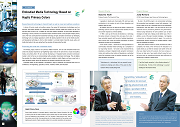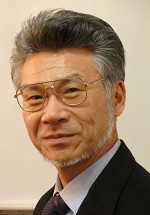- JST Home
- /
- Strategic Basic Research Programs
- /
 ACCEL
ACCEL- /
- R&D Projects/
- Completed/
- Embodied Media Technology based on Haptic Primary Colors
Embodied Media Technology based on Haptic Primary Colors

|
| Brochure PDF |
Research Director

Susumu Tachi
(Professor Emeritus, The University of Tokyo)
1973 Ph.D. The University of Tokyo
1973 Assistant Professor, The University of Tokyo
1975 Mechanical Engineering Laboratory, MITI (until 1990)
1979 Visiting Scientist, Massachusetts Institute of Technology (until 1980)
1989 Associate Professor, RCAST, The University of Tokyo
1992 Professor, RCAST, The University of Tokyo (until 2009)
1994 Professor, Faculty of Engineering, The University of Tokyo (until 2009)
2001 Professor, Graduate School of Information Science and Technology (until 2009)
2009 Professor Emeritus, The University of Tokyo
2009 Professor, Graduate School of Media Design, Keio University (until 2015)
Program Manager

Junji Nomura
(ACCEL Program Manager, Japan Science and Technology Agency)
1971 Bachelor of engineering, Kyoto University
1971 Entered Matsushita Electric Works. Co., Ltd.
1988 Ph.D. in engineering, Kyoto University
1997 Director, Systems Development Center
2009 Managing Director, Member of the Board, Panasonic Corporation
2010 Senior Managing Director, Member of the Board, Panasonic Corporation
2011 Corporate Advisor, Panasonic Corporation
2014 President, IEC(International Electrotechnical Commission)
2014 ACCEL Program Manager, JST
Outline of R&D Project
In the CREST Haptic Media project, we have developed a haptic sensation transmission technique based on the principle of haptic primary colors.1) We have presented its efficacy and usefulness through demonstration systems, including a 3D visuo-tactile sensation information presentation apparatus2) in which haptic sensation and 3D video are fused, and a telexistence3) robot that conveys haptic sensations. Thus, we have built the fundamental technology of haptic sensation transmission.
In the ACCEL Embodied Media project, we will further develop a compact and integrated tactile sensation transmission module based on the principle of haptic primary colors. By making it widely available to industrial and general users, we promote the early creation of products and services based on the recording, transmission, and reproduction of physical experiences with haptic sensations. We plan to build two demonstration systems: one is an embodied content platform with consideration of practical applications in the fields of broadcasting and entertainment, and the other is an embodied telexistence platform, which enables the emergence of new industries, such as a telework industry using alter-ego robots. We will intend to foster innovations with social and economic impacts through the proposed systems.
Note 1) The principle of haptic primary colors enables the measurement, transmission, and presentation of haptic sensations by interpreting haptic sensations as the integration of multiple sensory elements, such as pressure, vibration, and temperature (similar to the three primary colors in visual sensation) based on the mechanisms of human haptic sensations,.
Note 2) The 3D visual-tactile sensation information presentation apparatus displays a 3D video in the air. This video can be “touched” and manipulated by the hands, and it provides haptic sensations, thereby enabling users to “touch what is seen” in a “lived experience” in a virtual world.
Note 3) Telexistence technology enables a user to feel the experience of being in a robot and visiting a remote location. The robot—an alter ego of a human—is installed in a remote location. The user’s physical movement is synchronized with that of the robot, while the visual, audio, and tactile information acquired by the robot is transmitted to the user as if he or she were existing in the remote location















